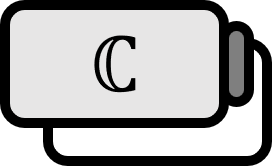Proof of ML Auxiliary Lemma
Theorem 1
Let’s say the function $f$ is piecewise continuous on the integration path $\mathscr{C}: z = z(t), t \in [a,b]$. If the positive number $\displaystyle L = \int_{a}^{b} |z’(t)| dt$ is the length of $\mathscr{C}$, and for all points on $\mathscr{C}$ there exists a positive number $M$ satisfying $|f(z)| \le M$, then $$ \left| \int_{\mathscr{C}} f(z) dz \right| \le ML $$
Proof
For the function $z’: [a,b] \to \mathbb{C}$ let’s say $\displaystyle \left| \int_{a}^{b} z’(t) dt \right| = r$.
If $r \ne 0$ then it can be represented as $\displaystyle \int_{a}^{b} z’(t) dt = r e^{i \theta}$. Then $\theta$ is a constant, therefore $$ r = \int_{a}^{b} e^{- i \theta} z’(t) dt \le \int_{a}^{b} \left| e^{- i \theta} z’(t) \right| dt = \int_{a}^{b} \left| e^{- i \theta} \right| \left| z’(t) \right| dt $$ Here, because the magnitude of a complex number’s real root is always 1, $\left| e^{ - i \theta} \right| = 1$. Thus, $$ \left| \int_{a}^{b} z’(t) dt \right| = r \le \int_{a}^{b} \left| z’(t) \right| dt $$ This demonstrates that the properties of definite integrals which hold for real functions are also valid for complex functions. Using the inequality derived above, we get $$ \begin{align*} \left| \int_{\mathscr{C}} f(z) dz \right| =& \left| \int_{a}^{b} f(z(t)) z’(t) dt \right| \\ \le & \int_{a}^{b} \left| f(z(t)) \right| \left| z’(t) \right| dt \\ =& \int_{a}^{b} M \left| z’(t) \right| dt \\ =& ML \end{align*} $$
■
Explanation
In the ML Lemma, M stands for Maximum, and L stands for Length.
What can be confusing when using the ML Lemma is how to choose $L$. Often in the original integral, $\mathscr{C}$ is given as a circle with radius $r$, and when substituting, the integration interval becomes $[0,2\pi]$. After substituting and applying the ML Lemma, one should use $2 \pi$, the length of the new integration interval, not $2\pi r$, the original circle’s circumference. In other words, it’s important to remember that you must apply the ML Lemma to the new curve (segment), $\mathscr{C} ' $, that emerges through substitution.
Osborne (1999). Complex variables and their applications: p76. ↩︎
